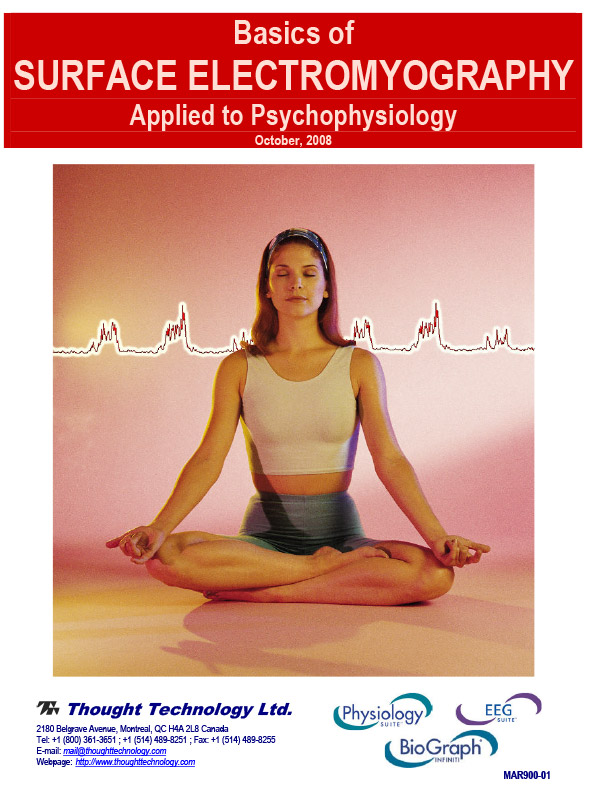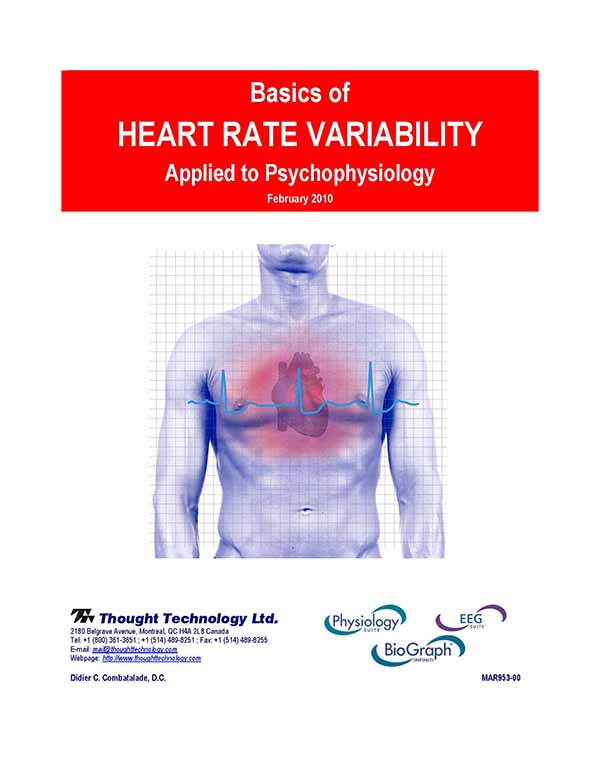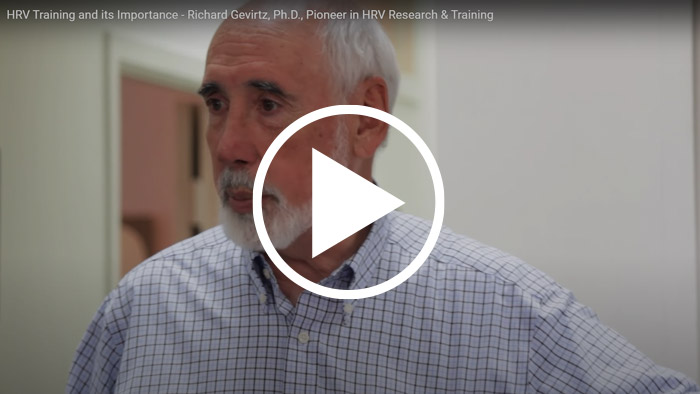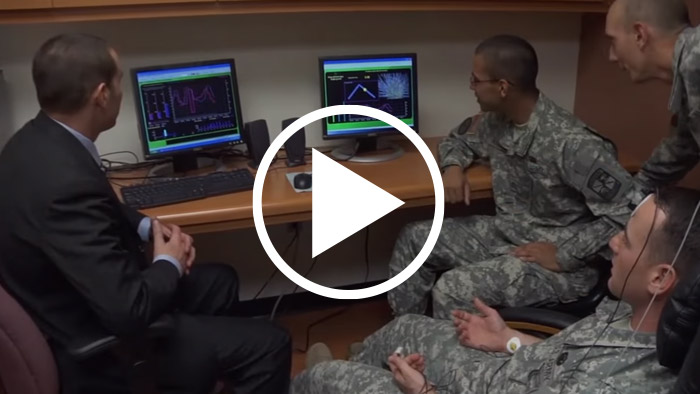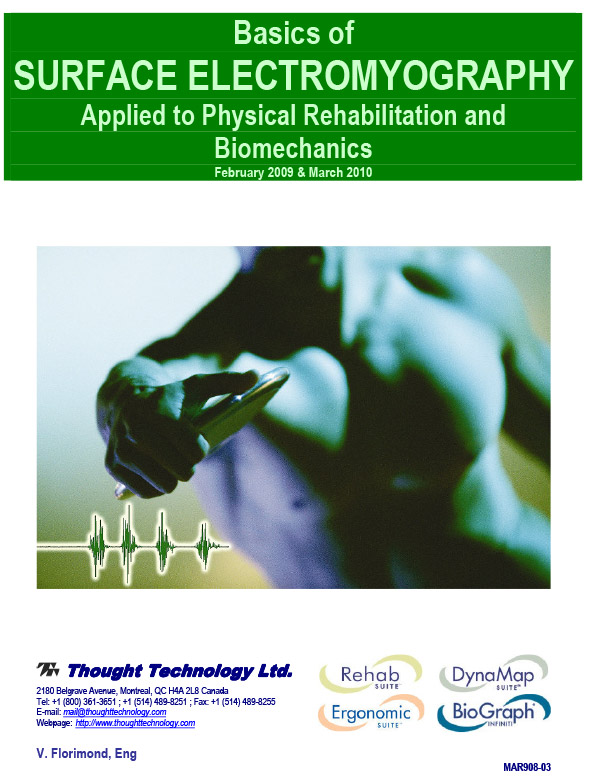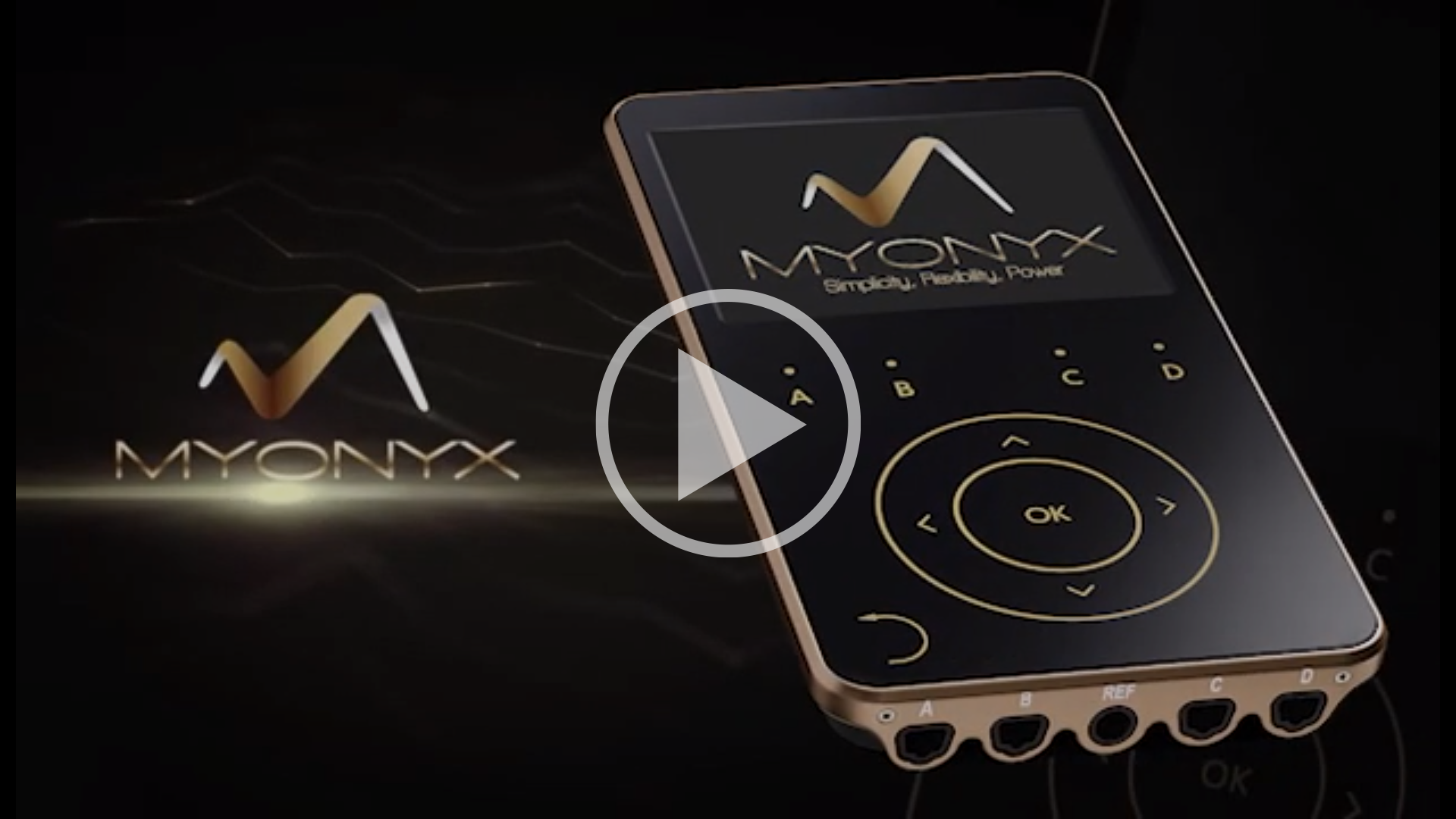Applications
-
Biofeedback
Biofeedback is a therapeutic method which uses the mind to help the body. It does this with specialized equipment that is designed to detect and amplify the subtle physiological processes related to stress and give instantaneous feedback on whether it increases or decreases, using audiovisual cues. This physiological mirroring creates a feedback loop which allows your client to become aware of, and learn to control, the mostly subconscious internal reactions to stress.
Classic biofeedback protocols use physiological sensors to measure arousal with skin conductance (GSR), peripheral blood flow with hand temperature, and muscle tension with electromyography (EMG). A multi-channel encoder device sends the physiological signals to a powerful data acquisition and multimedia biofeedback software to convert physiological changes into intuitive and understandable information that your client can use to learn self-regulation.
To get started, you can choose from a full range of starter, intermediate and expert bundled systems, pre-packaged with all you need to introduce classic biofeedback into your clinical practice or, if you prefer, put together your own system by picking and choosing individual components from our catalog. In either case, you can call our toll-free line and speak to one of our sales experts for assistance.
Our Starter, Intermediate and Expert system bundles are designed to meet the needs of novice and advanced biofeedback practitioners with any budget.
VIDEO: eVu-TPS: Triple-Physiology Sensor
Thought Technology's newest product, the eVu-TPS. A Wireless Triple-Physiology Sensor for Android Smart phones and Tablets.
Biofeedback Bundles
Discover all of our Biofeedback products
-
Heart rate variability
Heart rate variability (HRV) biofeedback is a specialized therapeutic method which focusses on breathing and its effect on heart rate. The heart’s beating rate is influenced by many different physiological factors but its strongest pacer is respiration. HRV training is a powerful tool which can, when used regularly, help expand the cardiovascular system’s resilience and flexibility, promote relaxation and wellbeing and counter the effects of prolonged stress.
A respiration sensor detects the expansion and contraction of the chest or abdomen associated with breathing while a finger pulse (blood volume pulse) or electrocardiograph (EKG) sensor picks up on beat to beat changes in heart rate. A multi-channel encoder device sends the physiological signals to a powerful data acquisition and multimedia biofeedback software to convert physiological changes into intuitive and understandable information that your client can use to learn self-regulation.
To get started, you can choose from a full range of starter, intermediate and expert bundled systems, pre-packaged with all you need to introduce HRV biofeedback into your clinical practice or, if you prefer, put together your own system by picking and choosing individual components from our catalog. In either case, you can call our toll-free line and speak to one of our sales experts for assistance.
Our Starter, Intermediate and Expert system bundles are designed to meet the needs of novice and advanced biofeedback practitioners with any budget.
HRV Bundles
Discover all of our heart rate variability products
-
Neurofeedback
Neurofeedback looks at the ebb and flow of brainwaves, picked up from the surface of the head. Electrodes are placed on one or two key locations on the scalp, following the International 10–20 system, and electroencephalography (EEG) sensors measure the tiny electrical signals generated by neurones closest to the electrodes. As different brain areas become engaged in mental activity, audiovisual feedback allows your client to learn to recognize shifts in mental states, such as drowsiness or focus, and voluntarily generate or inhibit specific frequencies at those selected locations.
Classic neurofeedback protocols are used to train standard frequency bands (delta, theta, alpha, beta and gamma) over selected brain areas, as well as specific frequencies on select locations, such as the sensory motor rhythm (SMR), picked up over the motor cortex. A Passive Infrared (pIR) sensor can be used to monitor and train changes in forehead temperature related to increasing or decreasing blood circulation. A multi-channel encoder device sends the physiological signals to a powerful data acquisition and multimedia biofeedback software to convert physiological changes into intuitive and understandable information that your client can use to learn self-regulation. Using operant conditioning methods, audiovisual feedback is used to reinforce the increase or decrease of targeted brainwave frequencies.
To get started, you can choose from a full range of starter, intermediate and expert bundled systems, pre-packaged with all you need to introduce neurofeedback into your clinical practice or, if you prefer, put together your own system by picking and choosing individual components from our catalog. In either case, you can call our toll-free line and speak to one of our sales experts for assistance.
Our Starter, Intermediate and Expert system bundles are designed to meet the needs of novice and advanced biofeedback practitioners with any budget.
Neurofeedback Bundles
Discover all of our Neurofeedback products
-
Muscle rehabilitation
Electromyography (EMG) biofeedback has been used for decades by physical therapists in order to help clients regain musculoskeletal function by enhancing fine control and increasing strength in selected muscles, as well as developing better balance between muscle groups. Electrical muscle stimulation (ESTIM), used alone or in conjunction with EMG biofeedback, is a powerful tool that can help restore muscle activity and strength in clients with partial loss of function and tonus.
Our EMG biofeedback systems come with one, two or more electromyography sensors. Sensors are placed on various muscle sites using adhesive electrode pads. Standard EMG biofeedback protocols are used to train clients to increase or decrease muscle activity of targeted muscles. Combining EMG biofeedback with ESTIM therapy expands the range of possible rehabilitation protocols. Our devices can be used stand-alone or connected to an Android device via an app, or to a PC with powerful Windows software.
To get started, you can choose from a full range of starter, intermediate and expert bundled systems, pre-packaged with all you need to introduce EMG biofeedback into your clinical practice or, if you prefer, put together your own system by picking and choosing individual components from our catalog. In either case, you can call our toll-free line and speak to one of our sales experts for assistance.
Our Starter, Intermediate and Expert system bundles are designed to meet the needs of novice and advanced biofeedback practitioners with any budget.
Basics of Surface Electromyography applied to physical rehabilitation and biomechanics
This document was written to assist you in using surface electromyography for biomechanics applications and physical rehabilitation.
Surface ElectroMyoGraphy (SEMG) is a non-invasive technique for measuring muscle electrical activity that occurs during muscle contraction and relaxation cycles.Muscle rehabilitation Bundles
Discover all of our Muscle rehabilitation products
-
Peak performance
Going beyond therapeutic applications, biofeedback for Peak performance aims at optimizing mental performance. Professionals who coach athletes, artistic performers and top executives combine classic biofeedback, heart rate variability (HRV) training and neurofeedback to help their clients perform at a consistently high level. Our peak performance products integrate powerful self-regulation protocols that will allow you to help clients retrain their autonomic nervous systems (ANS) to better handle stress, maximize HRV to increase their cardiovascular resilience and exercise their central nervous system (CNS) to access and sustain a state of optimum performance.
With our systems, you can give your performers advanced self-regulation skills,
Including:
• Conducting advanced HRV self-regulation training utilizing a respiration sensor and a finger pulse or EKG sensor
• Enhance your performers focus and concentration skills with EEG
• Improve their recovery to stress with skin conductance, hand temperature, and muscle tension sensors
A multi-channel encoder device sends the physiological signals to a powerful data acquisition and multimedia biofeedback software to convert physiological changes into intuitive and understandable information that your client can use to learn self-regulation.
To get started, you can choose from a full range of starter, intermediate and expert bundled systems, pre-packaged with all you need to introduce peak performance biofeedback into your clinical practice. You can also put together your own system by picking and choosing individual components from our catalog. In either case, you can call our toll-free line and speak to one of our sales experts for assistance. Our system bundles are designed to meet the needs of novice and advanced performance experts with any budget.
Peak performance Bundles
Discover all of our Peak performance products
-
Continence training
Electromyography (EMG) biofeedback is particularly useful in the treatments of urinary or fecal incontinence because it can help patients regain the ability to hold urine or stool by retraining sphincter muscle control and strength. Continence EMG biofeedback allows you to help your clients develop a better awareness of their pelvic floor muscles by practicing specific tasks, such as rapid contractions, contract and hold, and contract and relax. It is also useful in helping clients selectively isolate activity of the pelvic floor muscles from abdominal or leg muscle contractions.
Our EMG biofeedback for continence training come with one or two electromyography sensors and the choice of a vaginal or rectal probe to train pelvic floor muscles. A second EMG sensor can be used to down train co-contractions of abdominal or leg muscles. Standard EMG biofeedback protocols are used to practice various muscle control exercises, including work/rest, endurance and quick flicks. Our devices can be used stand-alone or connected to an Android device via an app, or to a PC with powerful Windows software.
To get started, you can choose from a full range of starter, intermediate and expert bundled systems, pre-packaged with all you need to introduce EMG biofeedback for continence training into your clinical practice or, if you prefer, put together your own system by picking and choosing individual components from our catalog. In either case, you can call our toll-free line and speak to one of our sales experts for assistance.
Our Starter, Intermediate and Expert system bundles are designed to meet the needs of novice and advanced biofeedback practitioners with any budget.
Learn more about the solutions available from ThoughtTech by viewing the Continence Brochure
Continence training Bundles
Discover all of our Continence training products
-
Research
Whether you are working in a corporate or university research laboratory, Thought Technology’s full range of physiological sensors, cables, accessories and multi-channel data acquisition systems will meet your needs at a competitive price. Use our systems to monitor and measure physiological activity from the autonomic and central nervous systems (ANS and CNS), respiratory and cardiovascular systems and musculoskeletal system with precision and confidence.
Our range of physiological sensors include skin conductance (arousal), temperature (peripheral blood flow), muscle tension (electromyography, RMS or raw), brainwaves (electroencephalography, including slow cortical potentials), heart rate (blood volume pulse or electrocardiography), breathing (respiration). Use one of our 2, 5, 8 or 10 channel encoder devices to connect to a powerful and fully configurable software to build acquisition protocols, play audio or visual cues and generate clean and artifact-free statistical data. Multiple data export options allow you to share data with third-party software, in real-time with TCP/IP, or offline via text files. Complete your kit with a wide selection of dry or gelled electrodes, extender cables, adapters, push buttons, voltage isolation devices, etc.
To get started, you can browser our product catalog or call our toll-free line and speak to one of our sales experts for assistance.
THOUGHT TECHNOLOGY SYSTEMS ARE USED BY RESEARCHERS ALL OVER THE WORLD IN A WIDE RANGE OF APPLICATIONS.
Depending on your research needs, you can count on Thought Technology’s research and development expertise to help you succeed and achieve your goal. Either use Thought Technology’s existing data acquisition systems with:
• TTL Customizable BioGraph Infiniti software developer tools
• TTL Connection Server SDK
• TTL Free flash animationsOr visit Thought Technology’s Science Division for packages tailored to your research and educational project’s needs
Research Bundles
Discover all of our Research products

